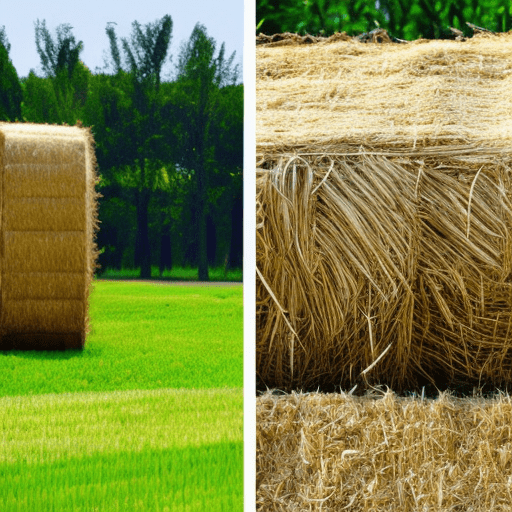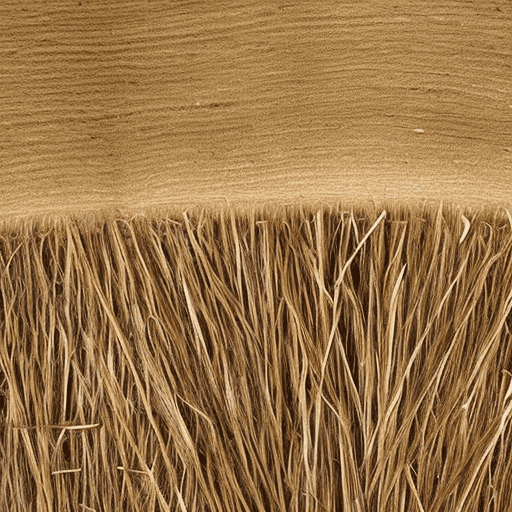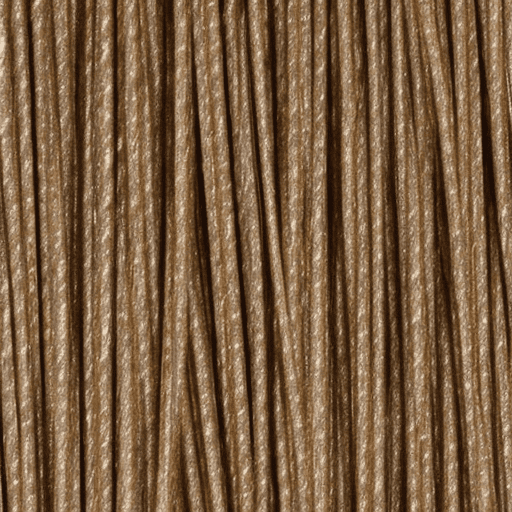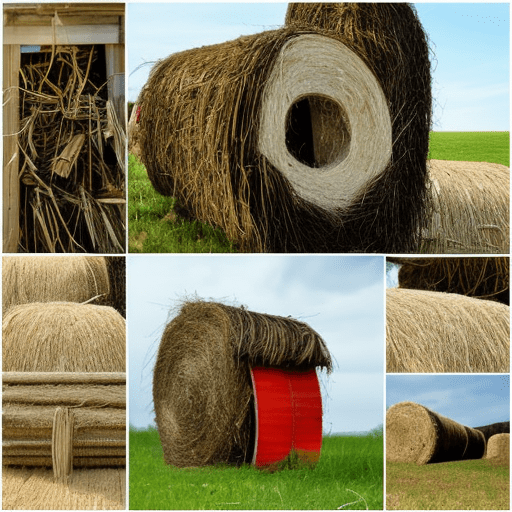When it comes to straw vs hay, there are a few things you need to know.
The 7 key differences between straw and hay are:
- Straw – The dry stalks left after grains like wheat, rice, oats, etc. are harvested. It is a by-product of growing grain crops.
- Hay – Grass, legumes, or other herbaceous plants that are cut, dried and stored as animal fodder. It is a primary crop grown specifically for use as livestock feed.
- Nutritional content – Hay has more nutrients like protein, carbohydrates, and vitamins that are needed for livestock. Straw is mainly fiber and lignin with fewer nutrients.
- Texture – Straw has a hollow tubular shape with distinct nodes. Hay is made up of dried grasses and plants so has more leafy, irregular shapes.
- Color – Straw is yellowish or golden. Hay can vary in shades of green, brown or yellow depending on the vegetation used.
- Uses – Straw is mainly used for bedding, gardening, and erosion control. Hay is specifically grown for consumption by grazing animals like cattle, horses, goats, etc.
- Production – Straw is a by-product of grain grown for human use. Hay is the primary crop grown explicitly for fodder.
So in summary, hay has more nutritional value as livestock feed, while straw is lower in nutrients and mainly used for bedding and other applications.
Both come from dried plant matter but are produced differently.

So which one should you choose for your needs?
- First of all, straw is made of stalks of grains, while hay is made of grasses.
- Secondly, straw is used for bedding and insulation, while hay is used for animal fodder.
- Finally, straw is often more expensive than hay.
Straw is the dried stalk of cereal grass, such as wheat, rye, or oats while the hay is dried grass that has been cut and left in the field to cure.
Both straw and hay are used as animal feed, but hay is also used as bedding for livestock.
- Straw is not commonly used as bedding because it tends to create more dust than hay.
- Additionally, straw can contain weed seeds that can sprout when it gets wet, while hay does not typically have this problem.
The difference between straw and hay
Hay is grass that has been cut and dried for animal feed, while straw is the dried stalks of grains like wheat or rye.

Hay is usually green in color, while straw is typically pale yellow.
Both hay and straw are high in fiber and low in sugar, making them good choices for cattle feed.
However, hay is generally more expensive than straw because it takes longer to grow and harvest.
In addition, hay is more likely to spoil than straw, so it must be stored carefully.
For these reasons, many farmers use straws as bedding for their livestock rather than feeding it to them.
What straw and hay are used for
Hay is a grass or legume that has been cut and dried for use as livestock feed.

Hay is typically fed to grazing animals, such as cattle, horses, goats, and sheep.
- Straw is the dry stalks of wheat, oats, barley, and rye after the grain has been harvested.
- It is often used as livestock bedding, or fodder, and can also be used in construction and crafts.
- In addition to being used as feed and bedding, straw and hay are also used in the production of biofuels, such as ethanol.
They can also be used as mulch to help suppress weed growth and protect plant roots from extreme temperatures.
As you can see, straw and hay have a variety of uses.
Pros and cons of straw vs hay

There are pros and cons to using straw vs hay in livestock feed.
Straw is the dried stalk of cereal grains, such as wheat, barley, oats, and rye.
It is a byproduct of grain harvest and usually has a lower nutritional value than hay.
Hay, on the other hand, is the grass that has been cut and dried for use as animal feed.
It generally has a higher nutritional value than straw.
One advantage of using straw over hay is that it is typically cheaper.
However, hay is often seen as a more premium feedstuff because of its higher nutritional value.
When deciding between straw and hay for livestock feed, farmers must weigh the pros and cons to determine which option is best for their operation.
How much does straw cost vs hay?
When it comes to feeding livestock, farmers have a choice between straw and hay.
Both are made from dried grass, but there are some important differences between the two.
- Hay is generally more expensive than straw, but it is also more nutritious.
- Hay is made from young, green grass that is cut before it goes to seed, while straw is made from the stalks of mature plants that have already flowered.
- As a result, hay typically contains more protein, vitamins, and minerals than straw.
- However, straw is rougher and coarser than hay, so it can be more difficult for animals to digest.
In addition, straw is often treated with pesticides, so it is important to check with the supplier before buying.
Ultimately, the choice between straw and hay depends on the needs of the farmer and the budget.
Which one should you choose for your needs?
When it comes to choosing the right type of product for your needs, it is important to consider your options carefully.
There are a wide variety of products on the market, and each has its own advantages and disadvantages.
- For example, some products are designed for use in specific environments, while others are more versatile.
- Additionally, some products are better suited for certain tasks than others.
- As such, it is important to read reviews and compare products before making a final decision.
- By taking the time to research your options, you can be sure to choose the product that best suits your needs.
- In conclusion, straw and hay have a variety of uses.
- Each has its own pros and cons, so it is important to choose the right one for your needs.
Consider your budget and the needs of your operation when making a decision.
By taking the time to research your options, you can be sure to find the best product for your needs
Article Sources
Jacks of Science sources the most authoritative, trustworthy, and highly recognized institutions for our article research. Learn more about our Editorial Teams process and diligence in verifying the accuracy of every article we publish.
